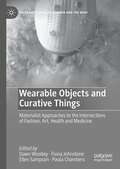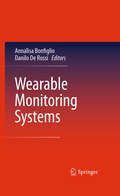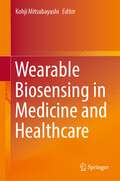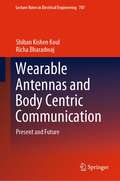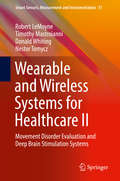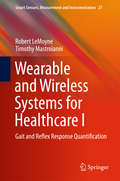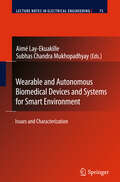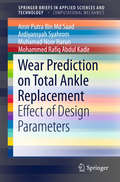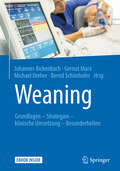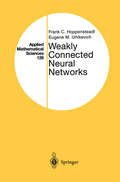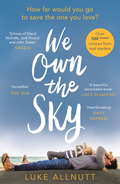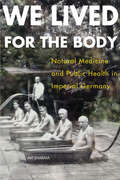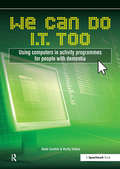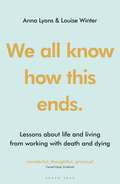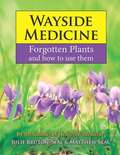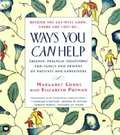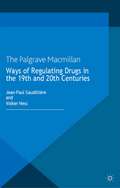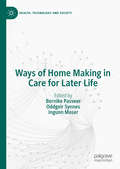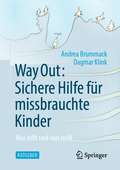- Table View
- List View
Wearable Objects and Curative Things: Materialist Approaches to the Intersections of Fashion, Art, Health and Medicine (Palgrave Studies in Fashion and the Body)
by Dawn Woolley Fiona Johnstone Ellen Sampson Paula ChambersThis book explores the intersections between wearable objects and human health, with particular emphasis on how artists and designers are creatively responding to and rethinking these relations. Addressing a rich range of wearable artefacts, from mobility aids and prosthetics to clothing and accessories to digital health tracking devices, its themes include care and cure; wellness culture and the commoditization of health; and the complex interactions between (human) bodies and (non-human) objects. With a theoretical framework inspired by the work of materialist thinkers including Sherry Turkle, Bruno Latour and Jane Bennett, and bringing the disciplinary fields of fashion studies, art and design practice, and medical and health humanities into dialogue for the first time, this volume draws attention to the complex agencies entangled in the things we wear, and situates fashion and art in relation to broader cultural and historical contexts of health, illness and disability.
Wearable Monitoring Systems
by Annalisa Bonfiglio and Danilo De RossiAs diverse as tomorrow’s society constituent groups may be, they will share the common requirements that their life should become safer and healthier, offering higher levels of effectiveness, communication and personal freedom. The key common part to all potential solutions fulfilling these requirements is wearable embedded systems, with longer periods of autonomy, offering wider functionality, more communication possibilities and increased computational power. As electronic and information systems on the human body, their role is to collect relevant physiological information, and to interface between humans and local and/or global information systems. Within this context, there is an increasing need for applications in diverse fields, from health to rescue to sport and even remote activities in space, to have real-time access to vital signs and other behavioral parameters for personalized healthcare, rescue operation planning, etc. This book’s coverage will span all scientific and technological areas that define wearable monitoring systems, including sensors, signal processing, energy, system integration, communications, and user interfaces. Six case studies will be used to illustrate the principles and practices introduced.
Wearable Biosensing in Medicine and Healthcare
by Kohji MitsubayashiThis book contains chapters on wearable biomedical sensors and their assistive technologies for promoting behavioral change in medical and health care. Part I reviews several wearable biomedical sensors based on biocompatible materials and nano and micro-electromechanical systems (MEMS) technologies in the medical and dental fields. Part II introduces the latest approaches to wearable biosensing using unique devices for various skin targets such as sweat, interstitial fluid, and transcutaneous gases. Part III presents technologies supporting wearable sensors, including soft and flexible materials, manufacturing methods, skin volatile-marker imaging, and energy harvesting devices.This book is intended for graduate students, academic researchers, and professors that work in medical and healthcare research fields, as well as industry professionals involved in the development of wearable and flexible sensing devices and measurement systems for human bio/chemical sensing, medical monitoring, and healthcare services, and for medical professionals and government officials who are driving behavior change in health care.
Wearable Antennas and Body Centric Communication: Present and Future (Lecture Notes in Electrical Engineering #787)
by Shiban Kishen Koul Richa BharadwajThis book presents state-of-the-art technologies, trends and applications with a focus on the healthcare domain for ultra-wideband (3.1–10.6 GHz) and 60 GHz (57–66 GHz) wireless communication systems. Due to various key features such as miniaturized antenna design, low power, high data rate, less effects on the human body, relatively less crowded spectrum, these technologies are becoming popular in various fields of biomedical applications and day-to-day life. The book highlights various aspects of these technologies related to body-centric communication, including antenna design requirements, channel modeling and characterization for WBANs, current fabrication and antenna design strategies for textile, flexible and implanted antennas. Apart from the general requirements and study related to these frequency bands, various application specific topics such as localization and tracking, physical activity recognition and assessment, vital sign monitoring and medical imaging are covered in detail. The book concludes with the glimpses of future aspects of the UWB and 60 GHz technology which includes IoT for healthcare and smart living, novel antenna materials and application of machine learning algorithms for overall performance enhancement.
Wearable and Wireless Systems for Healthcare II: Movement Disorder Evaluation and Deep Brain Stimulation Systems (Smart Sensors, Measurement and Instrumentation #31)
by Robert LeMoyne Timothy Mastroianni Donald Whiting Nestor TomyczThis book provides a far-sighted perspective on the role of wearable and wireless systems for movement disorder evaluation, such as Parkinson’s disease and Essential tremor. These observations are brought together in the application of quantified feedback for deep brain stimulation systems using the wireless accelerometer and gyroscope of a smartphone to determine tuning efficacy. The perspective of the book ranges from the pioneering application of these devices, such as the smartphone, for quantifying Parkinson’s disease and Essential tremor characteristics, to the current state of the art. Dr. LeMoyne has published multiple first-of-their-kind applications using smartphones to quantify movement disorder, with associated extrapolation to portable media devices.
Wearable and Wireless Systems for Healthcare I: Gait and Reflex Response Quantification (Smart Sensors, Measurement and Instrumentation #27)
by Robert LeMoyne Timothy MastroianniThis book provides visionary perspective and interpretation regarding the role of wearable and wireless systems for the domain of gait and reflex response quantification. These observations are brought together in their application to smartphones and other portable media devices to quantify gait and reflex response in the context of machine learning for diagnostic classification and integration with the Internet of things and cloud computing. The perspective of this book is from the first-in-the-world application of these devices, as in smartphones, for quantifying gait and reflex response, to the current state of the art. Dr. LeMoyne has published multiple groundbreaking applications using smartphones and portable media devices to quantify gait and reflex response.
Wearable and Wireless Systems for Healthcare I: Gait and Reflex Response Quantification (Smart Sensors, Measurement and Instrumentation #47)
by Timothy Mastroianni Robert LeMoyneThis book is the second edition of the one originally published in 2017. The original publication features the discovery of numerous novel applications for the use of smartphones and portable media devices for the quantification of gait, reflex response, and an assortment of other concepts that constitute first-in-the-world applications for these devices. Since the first edition, numerous evolutions involving the domain of wearable and wireless systems for healthcare have transpired warranting the publication of the second edition. This volume covers wearable and wireless systems for healthcare that are far more oriented to the unique requirements of the biomedical domain. The paradigm-shifting new wearables have been successfully applied to gait analysis, homebound therapy, and quantifiable exercise. Additionally, the confluence of wearable and wireless systems for healthcare with deep learning and neuromorphic applications for classification is addressed. The authors expect that these significant developments make this book valuable for all readers.
Wearable and Autonomous Biomedical Devices and Systems for Smart Environment: Issues and Characterization (Lecture Notes in Electrical Engineering #75)
by Aimé Lay-EkuakilleThis book is dedicated to wearable and autonomous systems, including devices, offers to variety of users, namely, master degree students, researchers and practitioners, An opportunity of a dedicated and a deep approach in order to improve their knowledge in this specific field. The book draws the attention about interesting aspects, as for instance, advanced wearable sensors for enabling applications, solutions for arthritic patients in their limited and conditioned movements, wearable gate analysis, energy harvesting, physiological parameter monitoring, communication, pathology detection , etc..
Wear Prediction on Total Ankle Replacement: Effect of Design Parameters (SpringerBriefs in Applied Sciences and Technology)
by Amir Putra Saad Ardiyansyah Syahrom Muhamad Noor Harun Mohammed Rafiq KadirThis book develops and analyses computational wear simulations of the total ankle replacement for the stance phase of gait cycle. The emphasis is put on the relevant design parameters. The book presents a model consisting of three components; tibial, bearing and talar representing their physiological functions.
Weaning: Grundlagen - Strategien - klinische Umsetzung - Besonderheiten
by Johannes Bickenbach Gernot Marx Michael Dreher Bernd SchönhoferIn diesem Werk beschreibt ein interdisziplinäres Herausgeber- und Autorenteam die Grundlagen, Strategien und Besonderheiten der Beatmungsentwöhnung („Weaning“). Das Buch wendet sich an alle Berufsgruppen, die Patienten im Weaningprozess betreuen, wie Intensivmediziner, Pneumologen, Pflegekräfte, Physiotherapeuten und Atmungstherapeuten. Dargestellt werden Ursachen, Pathophysiologie und Therapie des Weaningversagens, ebenso wie die Besonderheiten der Beatmungsentwöhnung bei Multimorbidität und bei Infektionen mit multiresistenten Erregern. Informationen zum Aufbau und Ausbau von Weaningstationen sowie zu Qualitätsmanagement und Zertifizierungskonzepten liefern wertvolles „Know-How“ für die Implementierung oder Weiterentwicklung einer Weaningstation. Auch ethische Aspekte am Lebensende von beatmeten Patienten werden ausführlich behandelt - ebenso wie telemedizinische Aspekte beim Weaning, die außerklinische Beatmung, neue Beatmungsverfahren sowie neue Verfahren der Bildgebung. Vor allem die Ausführungen zu wichtigen Weaningstrategien nehmen Bezug auf die S2k-Leitlinie zum prolongierten Weaning. Ein praxisnahes Werk mit zahlreichen Tipps und Fallbeispielen.
Weakly Connected Neural Networks (Applied Mathematical Sciences #126)
by Frank C. Hoppensteadt Eugene M. IzhikevichDevoted to local and global analysis of weakly connected systems with applications to neurosciences, this book uses bifurcation theory and canonical models as the major tools of analysis. It presents a systematic and well motivated development of both weakly connected system theory and mathematical neuroscience, addressing bifurcations in neuron and brain dynamics, synaptic organisations of the brain, and the nature of neural codes. The authors present classical results together with the most recent developments in the field, making this a useful reference for researchers and graduate students in various branches of mathematical neuroscience.
We Own The Sky: A heartbreaking page turner that will stay with you forever
by Luke AllnuttHow far would you go to save the one you love?"Anyone who wishes David Nicholls would write faster needs to grab this with both hands." Jill MansellAn emotional page-turner with a heart-pounding dilemma. Fans of Jodi Picoult, David Nicholls and Jojo Moyes will love We Own The Sky.Anna and Rob were the perfect couple with their whole lives in front of them. When beautiful baby boy Jack came along, their world seemed complete.But when tragedy strikes they are faced with an impossible choice. They have one chance to save their child, but at what cost?"...a touching narrative of first love and fatherhood" The Sunday Times****Praise for We Own The Sky'A beautiful, hugely emotional story.' - The Sun'A heartbreaking read about love and loss.' - Bella Magazine'Prepare to have your heart wrenched by this emotion-drenched story.' - Sunday Mirror'This tender depiction of a father's love for his son is utterly heartbreaking and will stay with you long after the book has finished.' - The Express'Deeply affecting. A beautiful, remarkable book.' - Lucy Diamond, author of The Secrets of HappinessUtterly beautiful, heartbreaking and ultimately uplifting. - Rachael Lucas, author of The State of GraceWhat an incredible book this is - such gut-wrenching honesty and depth of emotion. Anyone who wishes David Nicholls would write faster needs to grab this with both hands. It's a truly stunning achievement. - Jill MansellBeautifully rendered and profoundly moving, We Own the Sky illustrates the lengths we'll go to for those we love. Luke Allnutt is a major new talent in fiction and his debut is not to be missed. - Camille Pagán, bestselling author of Life and Other Near-Death Experiences*****What readers are saying about We Own The Sky:'Prepare to weep - I defy anyone to read this and not have a tear in their eye.' reviewer, 5 stars Emotional and moving. - 5* review, AmazonThis is a truly beautiful story told from the heart and written with such great feeling. - 5* review, AmazonI loved this book for its honesty, it's rawness and for its abundance of pure love. It made me laugh, it made me cry, and it will, I know, stay with me for a very long time. - 5* review, Amazon
We Lived for the Body: Natural Medicine and Public Health in Imperial Germany
by Avi SharmaNature was central to the Wilhelmine German experience. Medical cosmologies and reform-initiatives were a key to consumer practices and lifestyle choices. Nature's appeal transcended class, confession, and political party. Millions of Germans recognized that nature had healing effects and was intimately tied to quality of life. In the 1880s and 1890s, this preoccupation with nature became an increasingly important part of German popular culture.In this pioneering study, Avi Sharma shows that nature, health, and the body became essential ways of talking about real and imagined social and political problems. The practice of popular medicine in the Wilhelmine era brought nature back into urban everyday experience, transforming the everyday lives of ordinary citizens. Sharma explores the history of natural healing in Germany and shows how social and medical practices that now seem foreign to contemporary eyes were, just decades ago, familiar to everyone from small children to their aged grandparents, from tradesmen and women to research scientists. Natural healing was not simply a way to cure illness. It was also seen as a way to build a more healthful society. Using interpretive methods drawn from the history of science and science studies, Sharma provides a readable and groundbreaking inquiry into how popular health and hygiene movements shaped German ideas about progress, modernity, nature, health, and the body at the end of the 19th and the beginning of the 20th century.
We Can Do I.T. Too: Using Computers in Activity Programmes for People with Dementia
by Verity Stokes Nada SavitchUsing computers as part of activity programmes for people with dementia. Many people feel that computers and people with dementia don't mix. However computers and other digital gadgets such as cameras and phones are part of our lives and so it is important that people with dementia engage with these IT driven activities. This book demystifies the use of computers and other information technologies and provides a multitude of ideas and case-studies demonstrating how IT can be used effectively. Using computers in a variety of ways with people with dementia is extremely rewarding and benefits individuals, staff and family members. Based on real experiences this book is designed to inspire people working in any dementia service. It discusses why this is important, the multitude of uses and the practicalities of introducing I.T. activities. Recording people's lives - digital life story books; diary making things - calendars; photo albums; reminders helping with conversations - word finding; topics communicating with friends (email; Skype, social networking/discussion forums); helping with planning - personal planning; care plans; using services. It is suitable for care workers and managers, occupational and speech language therapists, specialist activity works and volunteers working people's homes, in day care, voluntary organisations or care homes.
We all know how this ends: Lessons about life and living from working with death and dying
by Anna Lyons Louise WinterWe all know how this ends is a new approach to death and dying, showing how exploring our mortality really can change our lives.If we acknowledge and accept our mortality, can we live a better life? If we embrace the end of life in the same way as we embrace the beginning, can we transform our lives?End-of-life doula Anna Lyons and funeral director Louise Winter have joined forces to share a collection of the heartbreaking, surprising and uplifting stories of the ordinary and extraordinary lives they encounter every single day. From working with the living, the dying, the dead and the grieving, Anna and Louise share the lessons they've learnt about life, death, love and loss.This is a book about life and living, as much as it's a book about death and dying. It's a reflection on the beauties, blessings and tragedies of life, the exquisite agony and ecstasy of being alive, and the fragility of everything we hold dear. It's as simple and as complicated as that.
We all know how this ends: Lessons about life and living from working with death and dying
by Anna Lyons Louise Winter'Wonderful, thoughtful, practical' - Cariad Lloyd, Griefcast'Encouraging and inspiring' - Dr Kathryn Mannix, author of Amazon bestseller With The End in MindEnd-of-life doula Anna Lyons and funeral director Louise Winter have joined forces to share a collection of the heartbreaking, surprising and uplifting stories of the ordinary and extraordinary lives they encounter every single day. From working with the living, the dying, the dead and the grieving, Anna and Louise reveal the lessons they've learned about life, death, love and loss. Together they've created a profound but practical guide to rethinking the one thing that's guaranteed to happen to us all. We are all going to die, and that's ok. Let's talk about it. This is a book about life and living, as much as it's a book about death and dying. It's a reflection on the beauties, blessings and tragedies of life, the exquisite agony and ecstasy of being alive, and the fragility of everything we hold dear. It's as simple and as complicated as that.
Wayside Medicine: Forgotten Plants and how to use them
by Julie Bruton-Seal Matthew SealWayside Medicine is packed with practical information on the use of over 50 native plants as sources of herbal medicine. The countryside abounds with cures which really work and cost a fraction of over-the-counter commercial brands. Have the satisfaction of picking and making your own simple herbal medicine, which has worked for centuries. The authors of Wayside Medicine remind us of a cornucopia of nature’s healing plants which have somehow been forgotten. Here are clear instructions from a renowned professional herbalist on how to make your own remedies: teas, oils, tinctures, poultices and creams. Stunning colour pictures accompany all the plants, as well as a comprehensive index matching health problems to the right herbal cure.
Ways You Can Help: Creative, Practical Suggestions for Family and Friends of Patient Care
by Margaret CookeDrawing on her own personal experience, Margaret Cooke offers sensitive, sensible advice to anyone who feels awkward or uncomfortable near people in emotional or physical pain.
Ways of Regulating Drugs in the 19th and 20th Centuries (Science, Technology and Medicine in Modern History)
by Jean-Paul Gaudillière and Volker HessThis collection takes the perspective that the historiography of science, technology, and medicine needs a broader approach toward regulation. The authors explore the distinct social worlds involved in regulation, the forms of evidence and expertise mobilized, and means of intervention chosen to tame drugs in factories, consulting rooms and courts.
Ways of Home Making in Care for Later Life (Health, Technology and Society)
by Bernike Pasveer Oddgeir Synnes Ingunn MoserThis is a book on how home is made when care enters the lives of people as they grow old at home or in ‘homely’ institutions. Throughout the book, contributors show how home is a verb: it is something people do. Home is thus always in the making, temporal, contested, and open to negotiation and experimentation. By bringing together approaches from STS, anthropology, health humanities and health care studies, the book points to the importance of people's tinkerings and experiments with making home, as it is here that home is being made and unmade.
Way Out: Was hilft und was heilt
by Andrea Brummack Dagmar KlinkDieser Ratgeber zeigt, was Eltern, Angehörige, aber auch Sozialpädagog*innen, Erzieher*innen und Lehrer*innen tun können, damit Kinder sexuelle Übergriffe gut verarbeiten und die traumatischen Folgen gelindert werden. Andrea Brummack und Dagmar Klink stellen Geschichten und Fallberichte von Kindern vor, die ihren Weg aus gefährlichen Ereignissen und Konflikten gefunden haben, sowie praktische Tipps und Prinzipien, um sexuelle Traumata zu lösen. Der Fokus liegt dabei auf zwei wichtigen Elementen: dem Umgang mit der durch den Schrecken verlorenen Sprache der Kinder sowie der Rolle des Tastsinns bei der Wiederherstellung positiver Assoziationen mit Berührung.
The Way of the Five Seasons: Living with the Five Elements for Physical, Emotional, and Spiritual Harmony
by John KirkwoodHere is a comprehensive and practical guide to using the Five Element model in your daily life in ways that can improve your physical health, foster mental ease and clarity, create more emotional balance, and bring you closer to spirit. Having introduced the philosophical and practical principles of the Five Elements, the author invites you to 'live the book', immersing yourself in the many aspects of each Element during its corresponding season. He offers a range of methods of doing this, including activities such as movement, cooking, gardening, journaling, visualisation, meditation, dialogue and self-acupressure. In working with each Element, he explores the three levels or expressions of human life - the physical (structures, organs, tissues and systems), the psycho-emotional (thoughts, beliefs, self-images, emotions and reactions), and the spirit. Detailed information is provided on each Element's specific attributes, associations, resonances and gifts, and anatomical illustrations are included for further guidance. An invaluable reference book for practitioners and students of Chinese Medicine who hope to become better practitioners to others, the book also provides the means to become a practitioner to yourself.
The Way of the Five Seasons: Living with the Five Elements for Physical, Emotional, and Spiritual Harmony (PDF)
by John KirkwoodHere is a comprehensive and practical guide to using the Five Element model in your daily life in ways that can improve your physical health, foster mental ease and clarity, create more emotional balance, and bring you closer to spirit. Having introduced the philosophical and practical principles of the Five Elements, the author invites you to 'live the book', immersing yourself in the many aspects of each Element during its corresponding season. He offers a range of methods of doing this, including activities such as movement, cooking, gardening, journaling, visualisation, meditation, dialogue and self-acupressure. In working with each Element, he explores the three levels or expressions of human life - the physical (structures, organs, tissues and systems), the psycho-emotional (thoughts, beliefs, self-images, emotions and reactions), and the spirit. Detailed information is provided on each Element's specific attributes, associations, resonances and gifts, and anatomical illustrations are included for further guidance. An invaluable reference book for practitioners and students of Chinese Medicine who hope to become better practitioners to others, the book also provides the means to become a practitioner to yourself.
The Way of the Five Elements: 52 weeks of powerful acupoints for physical, emotional, and spiritual health
by John KirkwoodFramed within the context of the modern, everyday world, this book takes a refreshing, anecdotal stroll through the healing principles of Chinese medicine, looking at key acupoints for each week of the year. The author journeys through the seasons of the Five Elements and within them the physical, emotional and spiritual associations of key acupoints, exploring their names, functions, and intensely practical healing use in the real world. The acupoints range from the point that can help with your sense of smell, through to the Fire points that can help with a good sense of humour. With clear descriptions and images that express the spirit of the season, and photographs of the point locations, this book is perfect for anyone interested in a different view of the body and its healing relation to the seasons, as well as students and practitioners of Chinese medicine looking for deep and memorable insight into their work.
